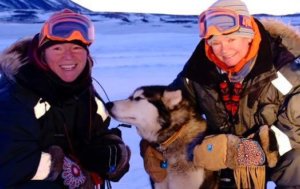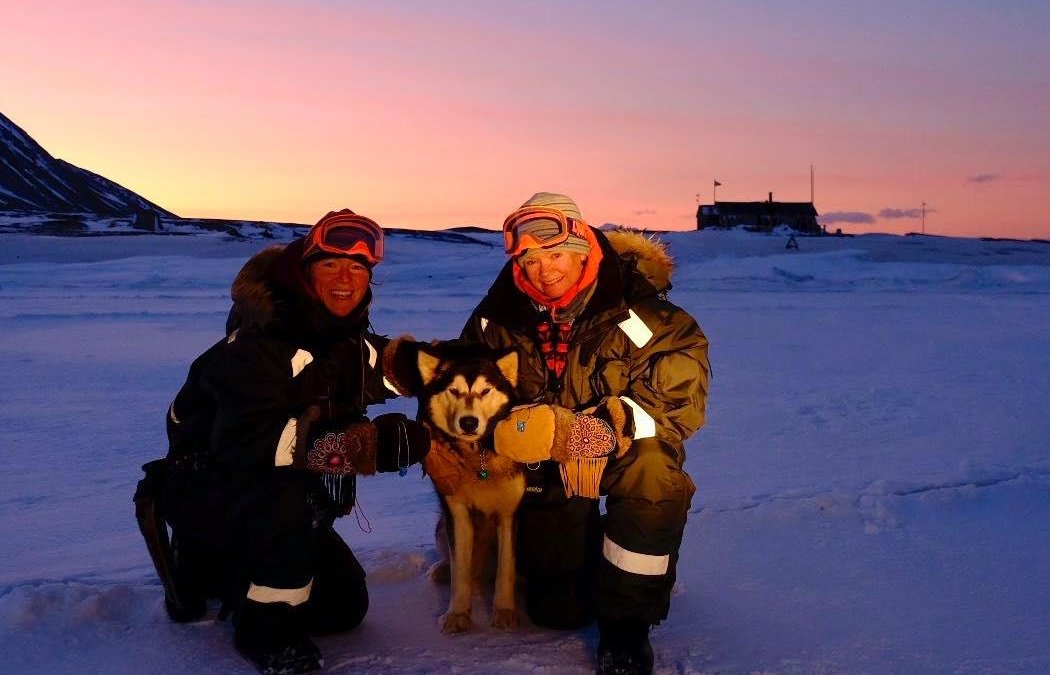”Slow down you move too fast,
you’ve got to make the morning last…. “
Simon and Garfunkel
Finally, a day without a lot of wind. Time stands in complete peaceful, stillness at Bamsebu. It’s almost an eerie stillness when the hut is not shaking. It makes us pause long enough to listen into the depth of the quiet as if a strange sound might mysteriously reveal itself. A deep breath of calm washes over us as the silence wraps around like a blanket.
Our view is one of white.
The light is coming.
The day has begun as pastel glows of pink and blue wrap the outer edges of the snow capped mountains that make up a scene we seem to stare at incessantly.
The 2 small windows facing east frame this scene. Hard to believe that for the past 3 months these little windows have been closed.
The very thick wooden shutters with 3 inch nails on the outside serving as a barrier between us, the harsh wind and the polar bears.We have been in Polar Darkness after all!
We literally threw those wooden shutters open and welcomed the world in on Feb 8th! Epic! Close to one million viewers came into our small 20 m2 space that is Bamsebu. The Norwegian TV NRK “Minutt for Minutt” in what they call “Slow TV”- showcased Svalbard and a day in August 2019 as we were getting setup for our overwintering.
People from around the world got to see Bamsebu so we thought we would share a bit about what we do on a given day. Some of it might surprise you.
First priority in the morning is to get the hut warm and it takes hours!
The hut was built in 1930, is not insulated and we feel it – the coldest it’s been inside is -3’c. Cold enough to make you feel like staying under the covers for a very long time. We put the firewood inside the wood burning stove from Grønt Maskin and start the heating process. No trees grow on Svalbard so the wood here has drifted in from Siberia and washed up on the shorelines. We have taken many trips before the ice came to collect and tow the logs back to be cut and stacked.
Depending on how early (ie; 6am?) we start the stove, we might go back to bed and sit with a down jacket on and read, write in our journals, reply to emails and sip coffee or tea. We check the wind and weather conditions, and check on Ettra. One of us gets dressed in our snowmobile suit and takes Ettra out to do her ‘business’ and checks around the hut for any wildlife or tracks.
We have oatmeal or love crunch cereal with healthy extras for breakfast.
Most things here are done “old school” since there is no running water or electricity. Everything takes its own time. We have an axe that we use to chop the wood and we use it to chop the ice that we have outside in a huge 1000 ltr container. We have 2 black plastic square 60 ltr tanks that sit side by side in the tiny kitchen that we drop the snow and ice in to melt. We use this for drinking water, dishes, cooking and cleaning ourselves and the random washing of clothes. Wool is fantastic – hardly any smell. Weather dependant we look at things like: Is it calm enough to fly the drone on its pre-programmed 15 min flight? Can we take the snowmobile out on the ice and collect ice cores for UNIS? Are there daytime Aurora to photograph for Nasa? Should we drop a net into our ice hole to collect for phytoplankton? Are there reindeer, Arctic fox or polar bear sightings to record for NPI? Does anything need fixing? Since the light is back – are there clouds to photograph and record for Nasa? Do we have interviews on the phone, do we have school calls to prepare for?
We go for daily walks with Ettra, always armed and fully layered. We plan our dinner and defrost what is frozen. We stay in touch with family, close friends and our science partners. We look at all of our other obligations and make sure we are on track every day. We write daily.
We train 6 days a week with TA2 bands and try to squeeze in pullups and 100 sit-ups every day. We stretch, do yoga. We empty the waste water bucket into a crack in the ice, we sort paper, plastic and metal waste. We empty food waste into a bear proof container.
We plan and share ideas on Hearts in the Ice – Embrace the Planet Project, what we will do after May 2020 and what else we can do to share, stay relevant and engage people?
We go outside to photograph the world that has become our dear friend.
February is a month of special light here in Svalbard. It is Valentine’s Day on the 14th and it is Citizen Science month for Hearts in the Ice! Please consider 2 things.
Purchase your very own “Hearts in the Ice Pendant” designed by the beautiful Ellen Kvam, each unique and made from recycled glass. Join us in sharing your love for the natural spaces that need our love and protection.

Get involved! Learning is a lifelong contribution to feel alive. Citizen science projects are perfect ways to learn and contribute to something people care about. Collecting data on a single insect or bird might mean very little – knowing that you do the same thing as thousands of other citizens with the same interest means a lot. Join one of our live school calls to learn more about Citizen Science from the Science Experts that need your help!
Read more about the schools calls.
“Hearts in the Ice is more than a project, more than two brave women managing to stay on their own during a polar winter. It is a model how scientists, industrial partners, explorers, artists and other stakeholders can meet around a common goal to focus on polar climate changes. They are following in the footsteps of other polar pioneers, but his time not hunting for fur and skins, but knowledge and wisdom” – Børge Damsgård, Director UNIS
Big hugs from Bamsebu, Sunniva and Hilde
We need your support! Your contribution will enable “Hearts in the Ice” to grow their reach and mission! Check out our fundraiser.


Nice to see the light coming back slowly into your world! I am sure it is a welcome window into everything around you both! I hope, in the end, you put all that you have done into written form, very interested to see what the research shows and what your studies find. So looking forward to seeing you both in May! I am very excited to sail to Bamsebu and see a little part of your world and explore the area! Big hugs to you both! ??❤️
Happy Valentine’s Day tomorrow girls ??❤️??
I’ll continue to follow you all the way through May
Happy Valentines Day to yous!!! Soak up all the love and gratitude coming your way! Light the way and carry on!❤️⭕️❌??
Happy Valentine’s day. It’s so interesting to follow you.
J’espère qu’un jour tu pourras me raconter de vive voix ton expérience. En regardant minutt by minutt j’ai cru reconnaitre certains endroits que j’ai vu lors de ma croisière à Svalbard. C’est vraiment très beau. Je te serai reconnaissante toute ma vie de m’avoir permis de faire ces beaux voyages. Be safe!
Happy Valentine’s Day! Keep up the posts as it is fun to learn more about that party of the world & how u are surviving. Love your fur baby I didn’t know you had a dog with you. Must be good company.
Happy Valentine’s Day – sending a warm hug!
Watched the footage from Day 8, and wish I could understand Norwegian! Thanks for the link. It was fun to see the shoreline and the inside of Bamsebu and to see you both. Must be great to have some light and to open the windows. Thanks for the description of your day – the small details make it all come alive for us. Big hugs!
I look forward to your posts describing the Polar world. This post particularly summarized your day, one much like any here at Carefree in Florida N. Ft Myers. Heat rather than cold considerations, Publix rather than frozen supplies (some frozen of course), women walking their dogs, cleaning around the mobile home looking for holes where critters could enter….the largest probably a Florida rat…and being amazed at sunset and sunrise which has come back for you. Thank you for your science to illuminate the world so that each routine day we all plan in our own culture stays lovely on the earth.